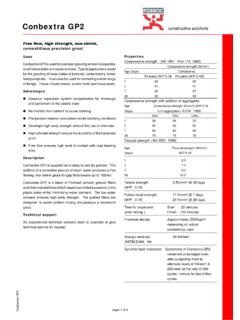Transcription of LINK BUDGET CALCULATIONS FOR A SATELLITE LINK WITH …
1 2019 Kymeta Corporation and its affiliates. KYMETA, CONNECTED BY KYMETA, MTENNA, K LO image, and K LO are trademarks of Kymeta Corporation, with registrations or pending applications for these marks in Brazil, the European Union, Japan, Norway, Singapore, South Korea, and the United States. All other trademarks are the property of their respective BUDGET CALCULATIONS FOR A SATELLITE LINK WITH AN ELECTRONICALLY STEERABLE ANTENNA TERMINAL1 JUNE 2019793-00004-000-REV01 2019 Kymeta Corporation and its affiliates.
2 KYMETA, CONNECTED BY KYMETA, MTENNA, K LO image, and K LO are trademarks of Kymeta Corporation, with registrations or pending applications for these marks in Brazil, the European Union, Japan, Norway, Singapore, South Korea, and the United States. All other trademarks are the property of their respective owners. 1 Introduction ..1 2 The ESA compared to the parabolic dish ..1 3 The three types of link budgets ..3 FWD link: hub to terminal ..4 Simple RTN link: terminal to SATELLITE ..4 Complex RTN link: terminal to SATELLITE and SATELLITE to hub.
3 4 4 Link components and their parameters ..5 Terminal ..5 Antenna scan angle and cosine Gain, noise temperature, and G/T ..6 Terminal Noise Temperature ..6 EIRP and EIRP density ..8 Transmission medium ..8 Free-Space Path Loss (FSPL) ..9 Atmospheric loss ..10 Rain fade and availability ..11 SATELLITE ..13 Transponder EIRP ..13 Saturation Flux Density (SFD), HPA back-off, and SATELLITE G/T ..14 Additional Factors Affecting.
4 15 Hub ..15 G/T ..15 5 Calculating SNR ..16 FWD equation ..16 Simple RTN equation ..16 Complex RTN equation ..17 If SATELLITE and hub parameters are not available ..17 6 Converting SNR to spectral efficiency and throughput ..17 MODCOD ..18 Spectral efficiency (SE) ..18 Throughput (data rate) ..19 7 Example link BUDGET SNR CALCULATIONS ..20 FWD link ..20 Simple RTN link ..21 Complex RTN link ..21 8 Conclusion.
5 22 9 References ..23 TABLE OF CONTENTS1 2019 Kymeta Corporation and its affiliates. KYMETA, CONNECTED BY KYMETA, MTENNA, K LO image, and K LO are trademarks of Kymeta Corporation, with registrations or pending applications for these marks in Brazil, the European Union, Japan, Norway, Singapore, South Korea, and the United States. All other trademarks are the property of their respective | INTRODUCTIONWhen designing a telecommunications system, one of the first and most important steps is to calculate a link BUDGET (also called a link analysis).
6 The link BUDGET is a theoretical calculation of the end-to-end performance of the communications link. It accounts for all the gains and losses of the link under a specific set of conditions, and the result of the analysis is a set of figures of merit that characterizes the quality of the link. The most common figures of merit are: SNR (signal-to-noise ratio) Spectral efficiency (bits per second/Hz) Throughput (bits per second)This paper shows you how to calculate the link BUDGET for a SATELLITE link that uses a flat panel, electronically steerable antenna (ESA) at the user terminal in mobility and fixed configurations.
7 Before performing some example CALCULATIONS , we ll first look briefly at the differences between a traditional parabolic dish antenna and an ESA, define three basic types of link budgets, and then identify the basic components of a SATELLITE link and their associated gains and losses. 2 | THE ESA COMPARED TO THE PARABOLIC DISHThe conventional method of communicating with a geostationary SATELLITE uses a parabolic dish antenna, which consists of a feed system and a passive parabolic reflector (Figure 1). The feed antenna is positioned in front of the reflector and illuminates it with radiation.
8 The parabolic shape of the reflector ensures that the paths of the radiation from the feed antenna to the reflector and outwards from the reflector are all the same length, so that they combine in phase to produce a plane wave. Also, the paths from the reflector outward are all in parallel. The result is an accurate, highly directional beam. The directivity of the dish antenna also applies to incoming signals, greatly reducing the received power of signals coming from satellites or other sources that the antenna is not pointed combination of high directivity and high radiation efficiency results in a high gain for the dish antenna.
9 The gain can be further increased by increasing the size of the stationary installations, the dish antenna can be set up, pointed at the SATELLITE , and calibrated just once. But if used in mobility applications, such as on a vehicle, it must be repositioned whenever the vehicle moves to keep it pointed at the SATELLITE . This requires a motorized mount, which adds bulk FIGURE 1. PARABOLIC DISH ANTENNA2 2019 Kymeta Corporation and its affiliates. KYMETA, CONNECTED BY KYMETA, MTENNA, K LO image, and K LO are trademarks of Kymeta Corporation, with registrations or pending applications for these marks in Brazil, the European Union, Japan, Norway, Singapore, South Korea, and the United States.
10 All other trademarks are the property of their respective weight, often making the dish antenna slow and cumbersome, or simply impractical for use, especially on smaller vehicles. The costs of manufacturing an accurate paraboloid reflector and a stable, precise gimbal mount can be high. Furthermore, the mount is subject to wear and mechanical failure from movement and from dirt intrusion. Flat panel antennas that electronically steer (scan) their beams to track satellites are an increasingly popular alternative to dish antennas (Figure 2).




